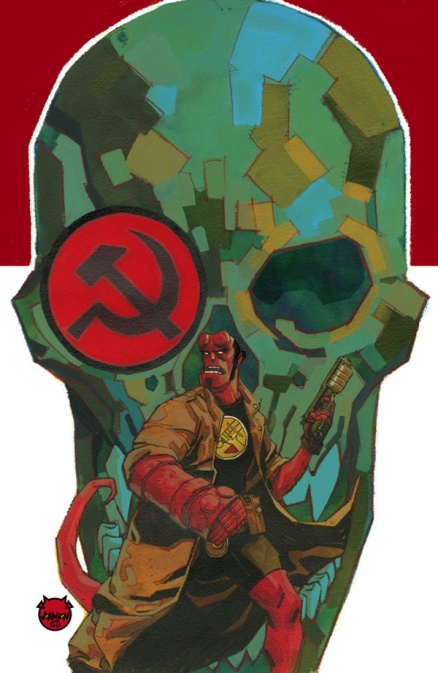
Welcome to Hell Notes, Multiversity Comics’ annotation column exploring Mike Mignola’s Hellboy Universe.
Those of you that’ve been reading “Hellboy and the B.P.R.D.” would have noticed that there’s been an Occult Cold War brewing between several paranormal agencies. For this Hell Notes, we’re going to take a look at each agency and the key players involved. To help me out, I’ve enlisted the services of “Hellboy and the B.P.R.D.” writer Chris Roberson. Think of this as your refresher course before ‘1956’ when it returns in November.
THE BUREAU FOR PARANORMAL RESEARCH AND DEFENSE
(B.P.R.D.)

Chris Roberson: Interestingly, with all of the different stories that have been told about the early days of the Bureau, we’ve never actually seen the earliest days. In 1944, Trevor was assisting the US Army in some capacity as a representative of the British Paranormal Society, and it’s been strongly hinted that the reason that Trevor when to the States in the first place was because that’s where young Hellboy was being taken. He continued to assist that US war effort in the final days of World War II, and somewhere along the way that lead to the formation of the Bureau, with the stated purpose of studying Hellboy and investigating the Nazis’ occult activities.
Mark: That’s not to say the Bureau doesn’t go on the offensive, though. In the early days, Bureau headquarters were at the Peerlo Air Force Base in New Mexico, and many of its early agents had military backgrounds.
Chris: One of the things that we’re exploring in the pages of “Hellboy and the B.P.R.D.” is the ways in which the Bureau gradually transitioned from a predominantly military operation (as it was in “B.P.R.D.: 1946”) to the more civilian-oriented government agency that we were introduced to in “Hellboy: Seed of Destruction.”
Mark: You can see that change already happening, starting when headquarters relocated to Fairfield, Connecticut in July 1947.
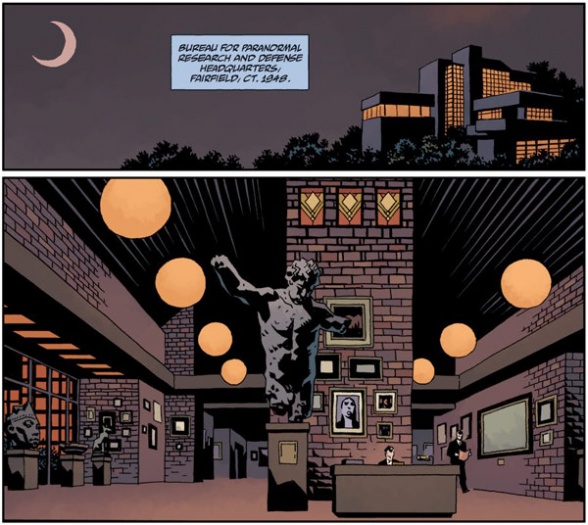
This would remain the Bureau’s home until October 2004, when they move into a secret government compound in Colorado to better combat a plague of frog monsters. The Colorado compound has an interesting history though, that’s closely tied to the 1950s Occult Cold War. We’ll certainly have more to say about it later…
B.P.R.D. PERSONNEL:
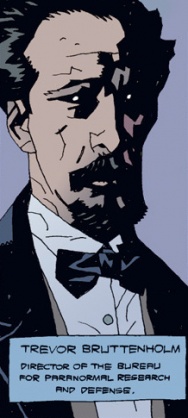
Mark: Born in Essex, 1918, Professor Bruttenholm is not exactly someone you’d immediately think would be the head of an organization like the B.P.R.D. For one thing, he was only twenty-six when he got the job, and as far as I know, he wasn’t even an American citizen at the time. However, few had experience like he had. He’d been a part of the British Paranormal Society from a young age and was referred to as a “paranormal Whiz Kid” by American troops—for good reason too.
Chris: It was established in Hellboy: The Companion that Trevor worked in military intelligence during the war, while continuing to study the occult and paranormal with his uncle. As we have since revealed in “Rasputin: The Voice of the Dragon,” those two aspects of his training—military intelligence and the occult—were far more intertwined than had previous been hinted, and in fact it was those wartime experiences, working to counter the Nazis’ occult programs both as a researcher in the rear echelon and as an agent behind enemy lines, that helped shape him into the man qualified to run the Bureau in the post-war years.
Continued belowMark: Not to mention his work in ’44, when he and Dr. Helena Gallaragas were working on Project Epimetheus together, building the Vril Energy Suit that would later become known as “Sledgehammer.” World War II certainly changed Bruttenholm enormously.
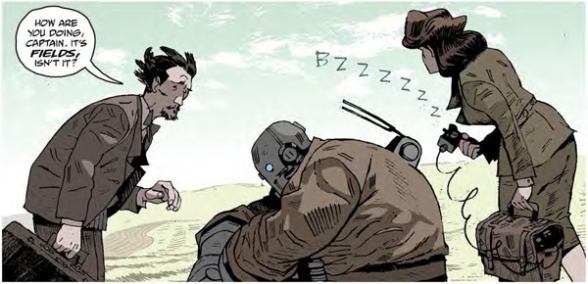
Still, as much as Bruttenholm is qualified for the job of director, it’s not one that suits him. He’s definitely a field agent at heart, and though we haven’t got to it yet in the pages of “Hellboy and the B.P.R.D.,” in 1958 he resigns from his position as director and becomes a field agent. In “B.P.R.D.: 1946–1948” and “Hellboy and the B.P.R.D.” we’ve seen a bit of that tug of war within him. He’s certainly a good director—especially since he views the supernatural as something more than just a nuisance to exterminate—but he really does feel trapped behind his desk at times, and when he’s out in the field he comes to life again.

Chris: My sense has always been that Trevor never set out to be the head of a large operation. He was more driven by his curiosity to learn everything he could about the paranormal, and later by the desire to protect and look after the young Hellboy, and the B.P.R.D. was the most expedient way to accomplish those goals. However, working with a handful of agents in the late ’40s was one thing, but by the end of the 1950s there were fifty agents on the team and a large support staff to oversee, and ultimately the demands of running the Bureau interfered with Trevor’s ability either to pursue his own intellectual curiosity or to spend time with Hellboy. Something that we’re exploring in the next few “Hellboy and the B.P.R.D.” storylines is the point at which that tension becomes too much for Trevor, and he begins to push back against it.
Hellboy, field agent
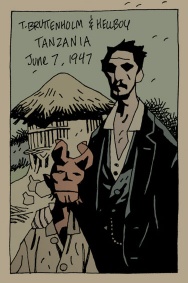
And during that scene Bruttenholm’s defending the scientists, I might add, so I wonder how far things went when he was a kid before Bruttenholm stepped in and said, “That’s enough.” Bruttenholm let things go pretty far when he let the Osiris Club test Hellboy in 1954 (see “Hellboy: The Nature of the Beast” and “The Visitor: How & Why He Stayed” #1) and when he loaned out Hellboy to Professor Aickman in 1956 (see “Hellboy: King Vold”). On both occasions, Hellboy nearly died. I wonder if perhaps it’s a bit of that British “stiff upper lip” attitude coming through.
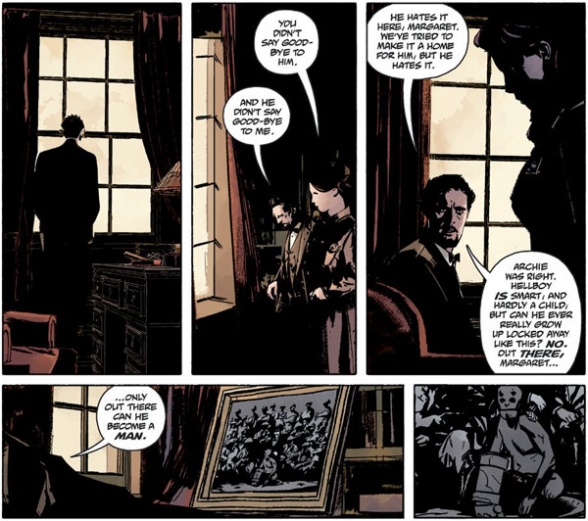
Chris: I don’t think that when Trevor took the infant demon in that he was thinking in terms of becoming a parent, but that’s certainly the role that he filled in young Hellboy’s life. He was clearly concerned for Hellboy’s wellbeing, making sure that he was looked after, but there’s definitely a kind of distance and reserve in their relationship. Now, that could be read literally as a bookish young researcher not quite realizing what he was getting himself into, but I think that figuratively that’s a dynamic that isn’t uncommon in the real world: parents who aren’t terribly great at relating to their children, and subsequently adults sometimes having difficulty navigating their relationships with their own parents. That quasi-father/son dynamic that Trevor and Hellboy share is one that has been explored a bit in the past, but we’ll be digging into it a little deeper in some forthcoming storylines.
Mark: Another key detail of Hellboy’s formative years is his relationship to guns. As a Bureau agent, Hellboy carries a gun, but he’s a lousy shot and he doesn’t like guns. Considering what happened in 1949 the first time he held one, I can’t blame him…
Continued below
Chris: That’s something I touched on briefly in my contribution to the recent prose anthology Hellboy: An Assortment of Horrors, in which a young Hellboy mentions his first time in the field to his new friend (who we haven’t seen the last of, by the way). That story was set in 1950, the year after the events in “B.P.R.D.: Hell on Earth—The Devil’s Wings” flashback, so the memory was still fresh in his mind, but I think that experience stuck with him. And I think that experience might have affected him in more ways that one, because he clearly struggled with the knowledge that he had killed someone, even if he was only acting to defend his friends. Throughout Hellboy’s later career, he always seems to be less interested in killing the monsters and bad guys than he is making sure that they aren’t hurting anyone. If they aren’t causing any trouble, Hellboy usually seems content to let them slink off back to the shadows.

Chris: That was something I saw as a key strength of the character from the earliest stories that Mike told. Whether it was with Liz, or Abe, or Roger, the B.P.R.D. was full of characters who under other circumstances might well have been seen as threats or even monsters in their own right, but who were welcomed as members of the team because Hellboy was in a position to see things from their perspective. So whenever possible I think it’s nice to see a younger Hellboy learning those lessons, and realizing that there are other ways of winning a fight than with guns and punches.
Lieutenant Archibald (Archie) Muraro, field agent
Mark: Let me tell you what I know about Archie: he’s a pilot, he makes great pancakes, he’s got the hots for Professor Bruttenholm’s secretary, Margaret, and he’s Hellboy’s best friend.

I can’t really say why he joined the B.P.R.D., but “B.P.R.D.: 1948” certainly hinted that it was because he wanted to keep an eye on Hellboy and make sure he was OK. As a field agent, his main contribution seems to be his abilities as a pilot, though he’s also shown himself to be pretty handy in a fight.
Chris: Considering how long Archie has been appearing in the comics, we’ve actually learned surprisingly little about him. But I’ve always felt that Hellboy must have looked up to him as a role model, a kind of virtual “big brother” or “cool uncle,” because a lot of Hellboy’s speech patterns and mannerisms in later life often sound a lot like things that Archie would have said. When we’ve had the chance to show flashbacks to earlier moments in Hellboy’s childhood, as in the first issue of “The Visitor: How & Why He Stayed,” I’ve always pushed for us to show young Hellboy palling around with Archie, tossing around a baseball or learning how to ride a bike. By the late 1950s Hellboy is effectively Archie’s peer, but I think that a lot of that early mentoring relationship is still in place, which is something that we’ll be looking into in some forthcoming stories.

Margaret Laine, secretary to the director
Mark: With most stories set out in the field, we don’t get to see a lot of Margaret, but she’s got a close relationship with Hellboy—she taught him to read—and she often serves as a counterpoint to Professor Bruttenholm, challenging his ideas when he needs it.
Chris: The timeline is a little fuzzy concerning just when Margaret started working with Trevor (at one point it’s mentioned that she was in London during the Blitz, an experience that he didn’t have), but by the time the Bureau was up and fully running Margaret was there acting as his assistant. And she continues in that capacity well into the 1950s and possibly beyond. We know from references in Hellboy: The Companion and elsewhere that Trevor begins to step away from an active role in running the Bureau on at least a couple of different occasions, and when we reach that point in the timeline we’ll begin to see Margaret take on a more prominent leadership role. And as with Archie, Margaret played a key role in Hellboy’s early development, as we’ve seen in “Hellboy: The Midnight Circus” and elsewhere, and just how that relationship changes over time is something that would be interesting to explore.
Continued below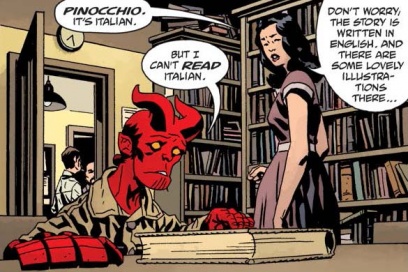
Susan Xiang, field agent
Mark: I’ve gotta say, Susan’s my favorite character in “Hellboy and the B.P.R.D.” Formerly an intelligence analyst for the F.B.I., Susan joined the Bureau in 1952. She and Hellboy got to be rookies together, and she warmed to Hellboy pretty much immediately. She’s good with languages (able to speak English, Mandarin Chinese, and Portuguese), and doesn’t flinch in a fight…

…oh, and she’s got psychic abilities (or more specifically, psychometric abilities).
Chris: When I came onboard during “Hellboy and the B.P.R.D.: 1953,” I was immediately attracted to Susan as a character. The little that had already been established about her personality, abilities, and background in the ‘1952’ miniseries by Mike and John Arcudi was already intriguing, and there was enough blank space in the canvas to explore some interesting territory with her. Things like establishing that her family had ties to a Chinese secret society of Taoist exorcists and monster fighters (the Golden Crane Society), and that the scope of her psychic abilities would expand over time, were ideas that we hit upon pretty early on, and as the stories progress that strength and reach of her psychic visions continue to grow. We know that she was still an active member of the team well into the 1960s, but in just what capacity has yet to be revealed. After all, she has glimpsed some pretty dire stuff in her visions of the future, and it remains to be seen whether she will still be around to witness those events first hand.

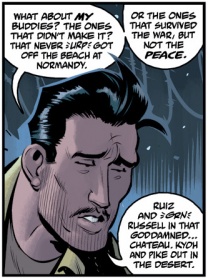
Mark: Aside from Bruttenholm himself, Jacob Stegner is probably the most senior field agent. Those early years of the B.P.R.D. had a really low survival rate, and to a certain extent I think Stegner carries that with him, though he tries to appear unaffected.
Chris: Something that we definitely made a point of touching on in ‘1955’ was that it is not lost on Jacob that he’s pretty much the only one of the old guard left. He has watched a LOT of friends and colleagues die, both during the war and in his time as a field agent for the Bureau. It may be something that only bubbles up to the surface after he’s had a few drinks, but he carries that stuff around with him all the time. And Jacob hasn’t forgotten that it was largely because of decisions that Professor Bruttenholm made back in ‘1948’ that a lot of his fellow agents lost their lives, and I think that he still has unresolved feelings about that.
Mark: And yet, he’s still stuck around. Stegner may act distant, but he’s actually rather loyal.

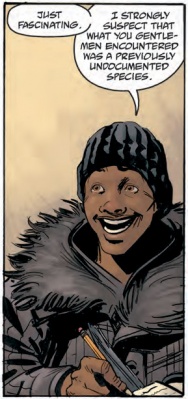
Mark: I would describe Woodrow as brimming with passion. He’s a cryptozoologist and his enthusiasm for his work is evident immediately. And that passion has helped sustain him in pursuits where his presence as a black man is routinely questioned. Yes, he’s found a place in the B.P.R.D., but even among his fellow agents he still encounters prejudice. The thing is, while there is understandably frustration and even anger there, Woodrow comes across as a joyful person. He truly feels born for working at the Bureau.
Chris: A lot of the inspiration for Woodrow came from stories about real-life African-American scientists of the period, who faced the same prejudices and frustrations, but persevered and succeeded despite of them. (None of them were cryptozoologists, of course, but there have to be some allowances for creative license!) And while I was conscious of wanting to have a diverse cast of characters, on the one hand I didn’t want to make the character’s defining characteristic the fact that he had to deal with racism, but on the other hand I thought it would be disingenuous to introduce an African-American character in mid-century America and pretend that he wouldn’t have been forced to deal with it. So prejudice and discrimination are things that frustrate and annoy him, but he’s far more concerned with the prospects of proving the existence of a new cryptid species.
Continued below
Doctor N.K. Sandhu, scientific advisor to the B.P.R.D.
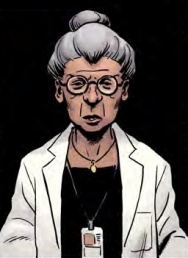
Chris: Dr. Sandhu’s role grew on the page, as it were. When she was first introduced, it was largely to serve as a sounding board for Susan, and someone who would have a more specialized understanding about Susan’s psychic abilities, based on years of study and research into that kind of phenomenon. It wasn’t until later when we were developing “Rise of the Black Flame” that we hit upon the idea that one of the characters there might be a member of her family, and that lead into all sorts of new and unexpected territory. As with Woodrow, Dr. Sandhu was also inspired by real history, in her case by the life stories of South Asian women who went into the sciences at a time when that was less common. But yes, there is definitely a great deal more that we have to explore with her.
Victor Koestler, ward of the B.P.R.D.
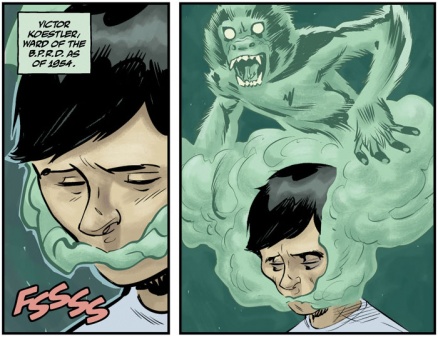
Chris: Victor’s entire story arc, from beginning to end, came into crystal focus in the course of one phone conversation that Mike and I had about the story that became “Unreasoning Beast.” Mike had the kernel of an idea for a story in his back pocket about a kid and a family haunted by an ectoplasmic ghost monkey, and had worked out the broad strokes about how it would play out. But in the course of that conversation I asked Mike what he thought happened to that kid in later life, and half an hour or so later we’d planned out his entire life, right up until the moment of his death. In part, it was an attempt to do in reverse what Mike had done with Liz Sherman, so that instead of introducing a field agent with strange abilities and revealing that they had been taken in by the Bureau as a child, introducing a child with strange abilities in one of these historical set pieces and then gradually aging them up over the course of time until they can join the team themselves. (It would have been a long time payoff that would have been years in coming, but when we did “The Visitor: How & Why He Stayed” it was too great of an opportunity to flashforward to Vic as a brash young adult to pass up!) But suffice it to say, oh yes, do we have plans for young Mr. Koestler…


THE SPECIAL SCIENCES SERVICE
(S.S.S.)
Mark: One of the things I enjoyed with “B.P.R.D.: Hell on Earth” was the way it took our expectations—that the Russian and American paranormal agencies would be adversarial—and turned it on its head. The S.S.S. and B.P.R.D. made fantastic allies.
But the 1950s are a very different era, and the S.S.S. is being run by a literal demon.
Chris: I’ve always been fascinated with the backstory of the S.S.S. from the little glimpses we got of it from stories that Mike and John Arcudi had done, and doing these stories set during the Cold War is a perfect opportunity to explore that era a little more deeply.
Continued belowS.S.S. PERSONNEL:
Varvara, director of the S.S.S.

Chris: Varvara is a fascinating character. In D&D terms I see her as being more Chaotic Neutral than anything else, mercurial and unpredictable. She’s capable of truly horrific atrocities at times, but at other times has come to Bruttenholm’s aid for no reason other than because she appears to like him. I spent a lot of time going back and revisiting the flashbacks we’ve seen to date of this period, particular those moments seen in “A Cold Day in Hell,” and yeah, as a boss? Terrifying.
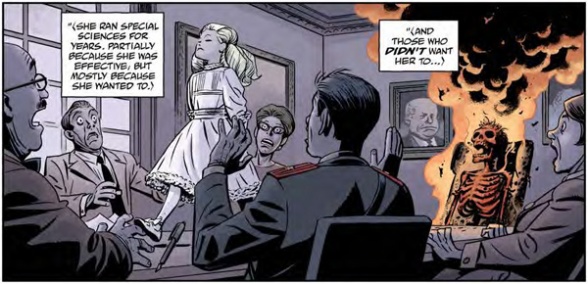

Mark: I think it’s fair to say Moravec falls on the more brutal end of the spectrum for government agents. He’s killed a few times already in the few stories he’s appeared. He also has a considerable chip on his shoulder where Hellboy is concerned. Moravec was tasked with securing Enkeladite for the S.S.S., and time and time again Hellboy’s thwarted Moravec’s attempts (despite Hellboy being utterly ignorant of Moravec’s existence until August, 1955). Considering some of the visions Susan Xiang’s had, it seems Moravec won’t let that chip go any time soon.
Chris: We haven’t fully explored just where Moravec comes from or the source of his abilities, but that’s something that we’ll be digging into in the very near future. But I liked the idea that this character would consider Hellboy to be his nemesis despite the fact that Hellboy had no idea that Moravec even existed. There is a bigger endgame in the works somewhere far over the horizon, but Moravec will definitely be up to some unpleasant business in the meantime.

Rahel Rebane, field agent
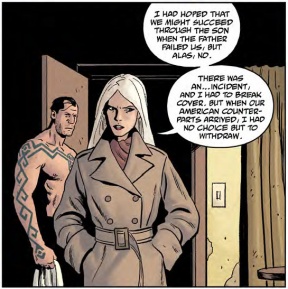
Chris: Rahel is another character who evolved on the page. Where Moravec has remained pretty close to his original conception, Rahel actually became a little more sympathetic over the course of scripting. In the original version of the outline she is just a remote observer to the events that unfold, and didn’t jump into the fray to help save that little boy. But as the story developed and she took a more central role in the mission to retrieve the Enkeladite, it just seemed to make sense that she would feel it was her responsibility to help save an innocent life if the need arose, even if it meant blowing her cover. We haven’t had as much opportunity to explore her explore her character in recent story arcs, but we definitely will be digging a little deeper into Rahel sooner or later.


THE SPECIAL INTELLIGENCE DIRECTORATE
(S.I.D.)
Mark: As of 1955, the S.I.D. and the B.P.R.D. are very much at odds with each other. “D,” the head of the S.I.D., has made it clear that the United Kingdom is their turf and the American B.P.R.D. is not welcome. I find this rather interesting, because we know that by 1959 Hellboy was on official operations in Ireland, and by 1966 operations in England. I could be wrong, but I even got the sense that the B.P.R.D. became a joint US/UK organisation.
Continued belowChris: This was a question that I had for Mike early on, because in stories set closer to the modern day, as in the early Hellboy miniseries, the B.P.R.D. has offices and branches all over the world, but back in 1948 it was just a few guys operating out of an Air Force base in the American desert, with close ties to the US military. At some point along the way the Bureau became a more international organization with a reduced emphasis on military ties, but when did that change? And what happened in the interim? Around the same time I was asking those questions, Mike and I independently hit upon the idea that other countries besides just the US and USSR would have had their own equivalent of the B.P.R.D., and the UK’s Special Intelligence Directorate was a direct outgrowth of those conversations. Just like the intelligence agencies of the US and the UK in our history, the B.P.R.D. and the S.I.D. might be on the same side, they might even consider one another allies, but they don’t necessarily always share the same priorities and agendas. For one thing, the S.I.D. is much more focused on using the paranormal as a means to an end, specifically for espionage purposes, than as something to research or to defend against (while the Soviet’s S.S.S. is much more concerned with weaponizing the paranormal to strengthen their position on the world stage).

Chris: The history of the S.I.D. is a little more wandering and haphazard than has been revealed so far, but the short version is that in Victoria’s time there were a number of different organizations involved with investigating or exploring the paranormal, including the Foundry, the British Paranormal Society, and even the Heliopic Brotherhood of Ra. In the early days of the Second World War, many of the surviving members of those groups were drafted into the war effort and put to work countering the Axis attempts to harness occult energies and technologies (and operating as it did out of former Foundry installation, came to use the Foundry’s old sword-and-anvil symbol). Professor Bruttenholm was a part of that effort, as was Lady Cynthia. Trevor went to America with Hellboy before the war was over, and so he wasn’t aware until some time later that the “occult division” of the War Office never really shut down, but transitioned into being the S.I.D., with a focus on espionage and keeping a lid on supernatural outbreaks clandestinely. Their field agents are more like spies than their American cousins, using code names drawn from old English poems and nursery rhymes.

THE CENTER FOR DEFENSE RESEARCH AND DEVELOPMENT
(C.D.R.D.)
Mark: When I first read ‘Occult Intelligence,’ I assumed it was the first appearance of the C.D.R.D., but they were actually introduced all the way back in “B.P.R.D.: The Dead” at the beginning of John Arcudi’s run on the series. In fact, the Bureau’s headquarters throughout most of the “Plague of Frogs” and “Hell on Earth” cycles was formerly the C.D.R.D.’s.
Founded in 1946, the C.D.R.D. was tasked with investigating alternative energy sources, including Vril. Part of their research even delved into the work of Professor Kyriakos Gallaragas, who built Prometheus, the original Vril Energy Suit. His daughter, Dr. Helena Gallaragas, worked extensively on the second Vril Energy Suit, Epimetheus (also known as Sledgehammer), so it’s possible she may be a part of the C.D.R.D. in the ’50s. It seems the most obvious place for her to end up after World War II.


Chris: Yeah, the C.D.R.D. has been hiding right there in plain sight since John Arcudi’s first run on “B.P.R.D.,” but they’ve pretty much been kept in the shadows. (And unless I’m misremembering, the name of the organization is only said once early on, and then never mentioned again until ‘Occult Intelligence.’) The motivation for revisiting them and expanding on them was looking back at the interplay between different intelligence agencies in US history, who often have different agendas and priorities of their own. And recognizing that not everyone in government would necessarily have been onboard with Professor Bruttenholm’s fairly optimistic and almost utopian view of the paranormal as something to be carefully studied and if possible domesticated. At the height of the Cold War there would surely have been those in the highest ranks of government who, if presented with a substance that creates monsters or an object that opens a doorway to hell, would look for a way to turn it into weapons to use against their enemies. That’s the C.D.R.D., and for them the occult and paranormal isn’t something to research or even defend against, but an arms race.

Mark: Ultimately, things did not go well for the C.D.R.D. An incident with Dr. Gunter Eiss in 1958 killed several of their best scientists and led to an entire basement being sealed off. The C.D.R.D. was officially decommissioned in September 1962.


THE SONNENRAD SOCIETY
Mark: In other words: Nazis. These guys always seem to be a thorn in Hellboy’s side, and in 1954’s ‘Black Sun,’ we’ve seen they’re still a big problem even after World War II.
Chris: We may have seen the last of Nazis for a while with ‘Black Sun.’ The idea there was to pick up on the mention of the Sonnenrad Society that was tucked away in Hellboy: The Companion (and connect them to the Nazis glimpsed watching von Klempt on a viewscreen in ‘1952’), and to explore a bit the idea that there were elements in the Nazi occult division who were very much in opposition to Rasputin and his pet projects, and who had ambitions of their own. And we talked a bit about the idea of building up this threat of Nazi flying saucers operating out of their hidden base at the bottom of the world, which has been a staple of these kinds of things since at least the days of Louis Pauwels and Jacques Bergier’s The Morning of the Magicians, which is kinda the taproot text for a lot of mid-century conspiracy theories. But I think it was Mike who suggested that as soon as we set up that threat that we just have Hellboy blow it all up and take them off the board. Because as much fun as it is to see Hellboy punch Nazis (and don’t get me wrong, it IS fun), we already have a good handle on who they are as characters and what their aims are. And in the mid-century period that we’re moving into with these stories, I think that the lines were often less cut and dried, and setting up the British and Soviets as sometimes-antagonists/maybe-sometimes-allies for the Bureau had more potential from a storytelling standpoint.
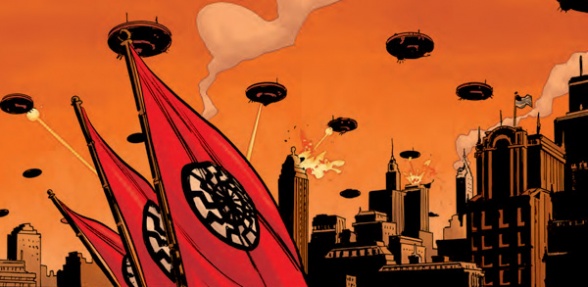
Mark: Probably the most notorious is Herman von Klempt, the head in a jar—he’s so extreme, even the other Sonnenrad Society members are disturbed by him.
Chris: I think that the Sonnerad Society mainly just thought that von Klempt was a lunatic, but yeah, ranting head-floating-in-a-jar is a hard look to pull off for anyone.
Mark: Hellboy bumped into von Klempt back in the ‘1952’ miniseries, and thanks to the non-linear approach Mike Mignola’s taken with the “Hellboy” series, we know he’ll bump into him again in the 1950s, culminating with a final encounter in Macapa, 1959. In this case, you’ll be connecting to a four-page promotional story Mike Mignola wrote back in 1994. Given that von Klempt is still active in “B.P.R.D.: The Devil You Know,” I get the feeling 1959’s going to be an interesting year when we get to it.
Continued belowChris: As for whether we’ll see one of those other encounters between him and Hellboy in the ’50s, I’m not sure. My instinct is usually to stay away from stories where we know for sure how they worked out unless we can come up with something new and interesting to reveal about that point in the characters’ lives, or something about the event that hasn’t been revealed to readers before now. But never say never!

“Hellboy and the B.P.R.D.: 1956” #1 comes out November 28, 2018 featuring art from Michael Avon Oeming (“B.P.R.D.: The Soul of Venice,” “Abe Sapien: The Land of the Dead,” and “Mood Swings”), Mike Norton (“B.P.R.D.: Hell on Earth—The Exorcist”), and Hellboy Universe newcomer Yishan Li. Be sure to place your order at your local comicbook store before November 5.
HELLBOY AND THE B.P.R.D.: 1956 #1 (of 5)
Written by Mike Mignola and Chris Roberson
Illustrated by Yishan Li, Mike Norton, and Michael Avon Oeming
Color by Dave StewartPressure is mounting within the bureau to uncover the Soviets’ secret plans, but a suspicious cover-up leads one agent off the radar in search of answers. Meanwhile, demonic Soviet occult leader Varvara pushes her team to follow her own whims, and Hellboy is sent on the mission that led to his infamous misadventures in Mexico. But even more clandestine plots are at work—both inside the B.P.R.D. and out.
• Three Hellboy and the B.P.R.D. storylines interwoven into an espionage saga
This article features artwork from Paul Azaceta, Gabriel Bá, Laurence Campbell, Brian Churilla, Guy Davis, D’Israeli, Duncan Fegredo, Stephen Green, Paul Grist, Dave Johnson, Jason Latour, Alex Maleev, Shawn Martinbrough, Mike Mignola, Paolo Rivera, Peter Snejbjerg, and Ben Stenbeck.

